MITSUBISHI OUTLANDER SPORT 2015 3.G Owners Manual
Manufacturer: MITSUBISHI, Model Year: 2015, Model line: OUTLANDER SPORT, Model: MITSUBISHI OUTLANDER SPORT 2015 3.GPages: 384, PDF Size: 61.37 MB
Page 361 of 384
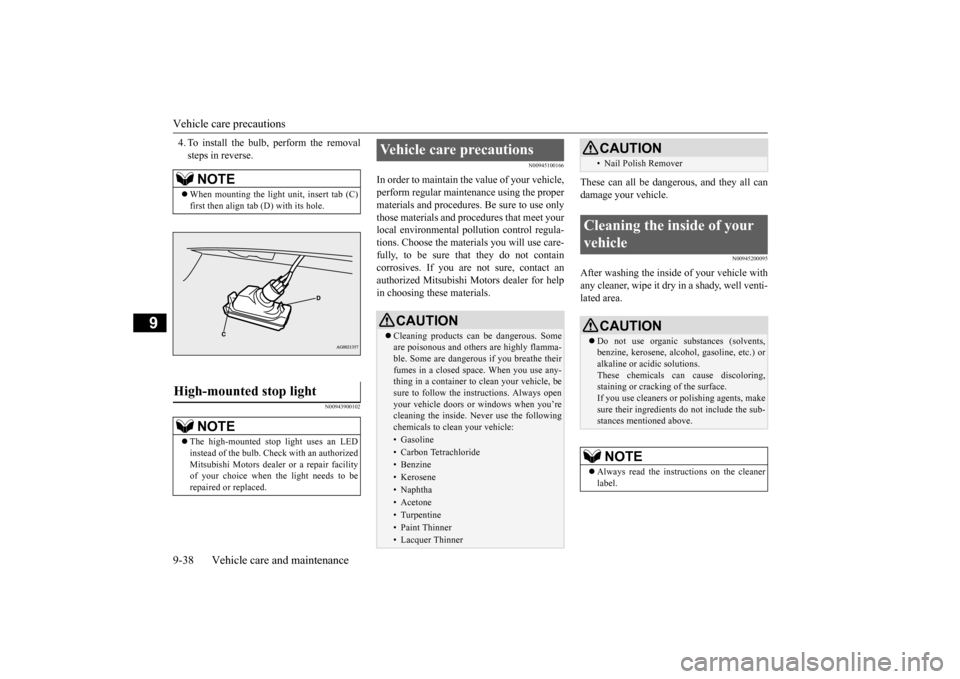
Vehicle care precautions 9-38 Vehicle care and maintenance
9
4. To install the bulb, perform the removal steps in reverse.
N00943900102
N00945100166
In order to maintain the value of your vehicle, perform regular maintenance using the propermaterials and procedures. Be sure to use only those materials and procedures that meet your local environmental pollution control regula-tions. Choose the materials you will use care- fully, to be sure that they do not contain corrosives. If you are not sure, contact anauthorized Mitsubishi Motors dealer for helpin choosing these materials.
These can all be dangerous, and they all can damage your vehicle.
N00945200095
After washing the inside of your vehicle withany cleaner, wipe it dry in a shady, well venti-lated area.
NOTE
When mounting the light unit, insert tab (C) first then align tab (D) with its hole.
High-mounted stop light
NOTE
The high-mounted stop light uses an LED instead of the bulb. Check with an authorized Mitsubishi Motors dealer or a repair facility of your choice when the light needs to berepaired or replaced.
Vehicle care precautions
CAUTION Cleaning products can be dangerous. Some are poisonous and others are highly flamma- ble. Some are dangerous if you breathe their fumes in a closed space. When you use any-thing in a container to clean your vehicle, be sure to follow the instructions. Always open your vehicle doors or windows when you’recleaning the inside. Never use the following chemicals to clean your vehicle:• Gasoline• Carbon Tetrachloride• Benzine• Kerosene• Naphtha• Acetone• Turpentine• Paint Thinner• Lacquer Thinner
• Nail Polish Remover
Cleaning the inside of your vehicle
CAUTION Do not use organic substances (solvents, benzine, kerosene, alcohol, gasoline, etc.) or alkaline or acidic solutions. These chemicals can cause discoloring,staining or cracking of the surface. If you use cleaners or polishing agents, make sure their ingredients do not include the sub-stances mentioned above.NOTE
Always read the instructions on the cleaner label.CAUTION
BK0206700US.bo
ok 38 ページ 2014年3月25日 火曜日 午後4時42分
Page 362 of 384
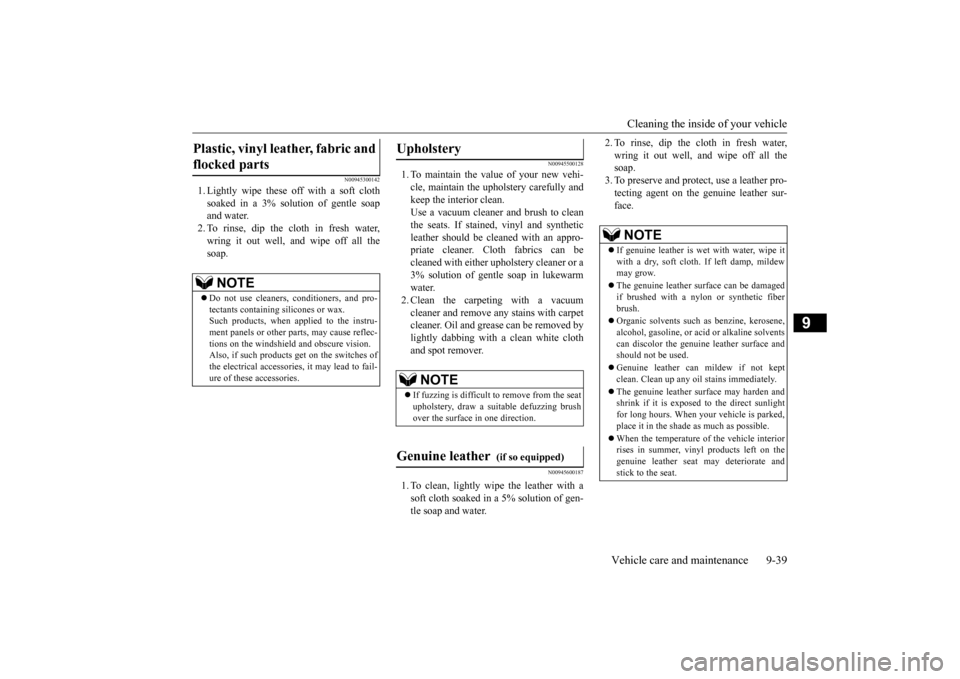
Cleaning the inside of your vehicle
Vehicle care and maintenance 9-39
9
N00945300142
1. Lightly wipe these off with a soft cloth soaked in a 3% solution of gentle soap and water. 2. To rinse, dip the cloth in fresh water,wring it out well, and wipe off all the soap.
N00945500128
1. To maintain the value of your new vehi- cle, maintain the upholstery carefully andkeep the interior clean. Use a vacuum cleaner and brush to clean the seats. If stained, vinyl and syntheticleather should be cleaned with an appro- priate cleaner. Cloth fabrics can be cleaned with either upholstery cleaner or a3% solution of gentle soap in lukewarmwater. 2. Clean the carpeting with a vacuum cleaner and remove any stains with carpetcleaner. Oil and grease can be removed by lightly dabbing with a clean white cloth and spot remover.
N00945600187
1. To clean, lightly wipe the leather with asoft cloth soaked in a 5% solution of gen- tle soap and water.
2. To rinse, dip the cloth in fresh water, wring it out well, and wipe off all the soap. 3. To preserve and protect, use a leather pro-tecting agent on the genuine leather sur- face.
Plastic, vinyl leather, fabric and flocked parts
NOTE
Do not use cleaners, conditioners, and pro- tectants containing silicones or wax. Such products, when applied to the instru- ment panels or other parts, may cause reflec-tions on the windshield and obscure vision. Also, if such products get on the switches of the electrical accessories, it may lead to fail-ure of these accessories.
Upholstery
NOTE
If fuzzing is difficult to remove from the seat upholstery, draw a suitable defuzzing brush over the surface in one direction.
Genuine leather
(if so equipped)
NOTE
If genuine leather is wet with water, wipe it with a dry, soft cloth. If left damp, mildew may grow. The genuine leather surface can be damaged if brushed with a nylon or synthetic fiber brush. Organic solvents such as benzine, kerosene, alcohol, gasoline, or acid or alkaline solventscan discolor the genuine leather surface and should not be used. Genuine leather can mildew if not kept clean. Clean up any oil stains immediately. The genuine leather surface may harden and shrink if it is exposed to the direct sunlight for long hours. When your vehicle is parked,place it in the shade as much as possible. When the temperature of the vehicle interior rises in summer, vinyl products left on the genuine leather seat may deteriorate and stick to the seat.
BK0206700US.bo
ok 39 ページ 2014年3月25日 火曜日 午後4時42分
Page 363 of 384
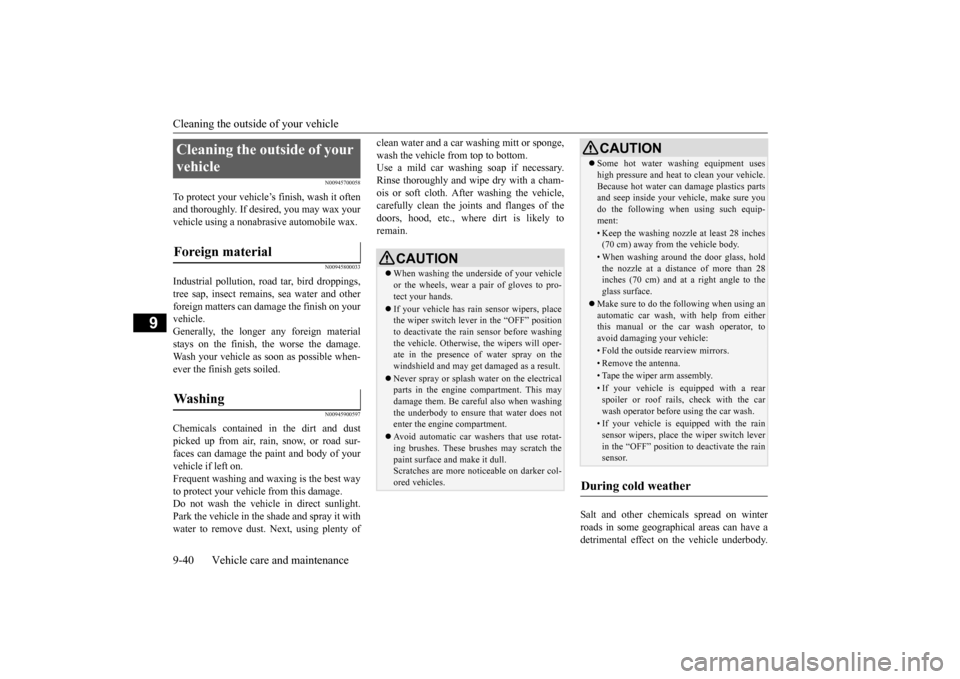
Cleaning the outside of your vehicle 9-40 Vehicle care and maintenance
9
N00945700058
To protect your vehicle’s finish, wash it often and thoroughly. If desired, you may wax yourvehicle using a nonabrasive automobile wax.
N00945800033
Industrial pollution, road tar, bird droppings,tree sap, insect remains, sea water and otherforeign matters can damage the finish on your vehicle. Generally, the longer any foreign materialstays on the finish, the worse the damage. Wash your vehicle as soon as possible when- ever the finish gets soiled.
N00945900597
Chemicals contained in the dirt and dustpicked up from air, rain, snow, or road sur-faces can damage the paint and body of your vehicle if left on. Frequent washing and waxing is the best wayto protect your vehicle from this damage. Do not wash the vehicle in direct sunlight. Park the vehicle in the shade and spray it withwater to remove dust. Next, using plenty of
clean water and a car washing mitt or sponge, wash the vehicle from top to bottom. Use a mild car washing soap if necessary. Rinse thoroughly and wipe dry with a cham-ois or soft cloth. After washing the vehicle, carefully clean the joints and flanges of the doors, hood, etc., where dirt is likely toremain.
Salt and other chemicals spread on winter roads in some geographical areas can have a detrimental effect on the vehicle underbody.
Cleaning the outside of your vehicle Foreign material Wa s h i n g
CAUTION When washing the underside of your vehicle or the wheels, wear a pair of gloves to pro- tect your hands. If your vehicle has rain sensor wipers, place the wiper switch lever in the “OFF” positionto deactivate the rain sensor before washing the vehicle. Otherwise, the wipers will oper- ate in the presence of water spray on thewindshield and may get damaged as a result. Never spray or splash water on the electrical parts in the engine compartment. This may damage them. Be careful also when washing the underbody to ensure that water does notenter the engine compartment. Avoid automatic car washers that use rotat- ing brushes. These brushes may scratch the paint surface and make it dull. Scratches are more noticeable on darker col- ored vehicles.
Some hot water washing equipment uses high pressure and heat to clean your vehicle. Because hot water can damage plastics parts and seep inside your vehicle, make sure you do the following when using such equip-ment:• Keep the washing nozzle at least 28 inches(70 cm) away from the vehicle body.• When washing around the door glass, holdthe nozzle at a distance of more than 28 inches (70 cm) and at a right angle to the glass surface.
Make sure to do the following when using an automatic car wash, with help from eitherthis manual or the car wash operator, to avoid damaging your vehicle:• Fold the outside rearview mirrors.• Remove the antenna.• Tape the wiper arm assembly.• If your vehicle is equipped with a rearspoiler or roof rails, check with the car wash operator before using the car wash.• If your vehicle is equipped with the rainsensor wipers, place the wiper switch leverin the “OFF” position to deactivate the rain sensor.
During cold weather
CAUTION
BK0206700US.bo
ok 40 ページ 2014年3月25日 火曜日 午後4時42分
Page 364 of 384
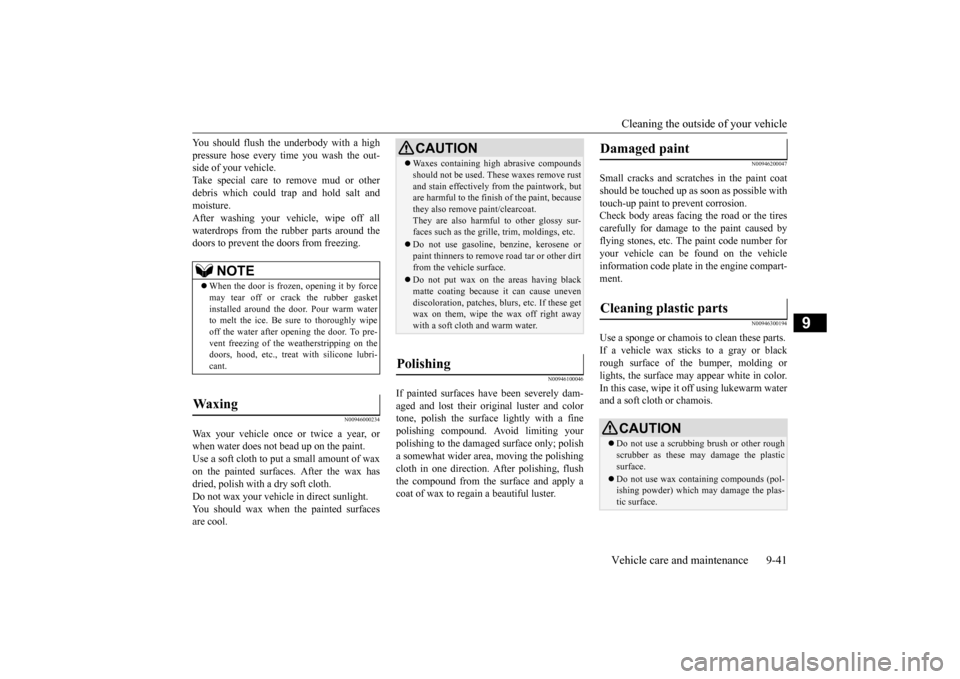
Cleaning the outside of your vehicle Vehicle care and maintenance 9-41
9
You should flush the underbody with a high pressure hose every time you wash the out- side of your vehicle. Take special care to remove mud or otherdebris which could trap and hold salt and moisture. After washing your vehicle, wipe off allwaterdrops from the rubber parts around the doors to prevent the doors from freezing.
N00946000234
Wax your vehicle once or twice a year, or when water does not bead up on the paint.Use a soft cloth to put a small amount of wax on the painted surfaces. After the wax has dried, polish with a dry soft cloth.Do not wax your vehicle in direct sunlight. You should wax when the painted surfaces are cool.
N00946100046
If painted surfaces have been severely dam-aged and lost their original luster and color tone, polish the surface lightly with a fine polishing compound. Avoid limiting yourpolishing to the damaged surface only; polish a somewhat wider area, moving the polishing cloth in one direction. After polishing, flushthe compound from the surface and apply a coat of wax to regain a beautiful luster.
N00946200047
Small cracks and scratches in the paint coat should be touched up as soon as possible withtouch-up paint to prevent corrosion. Check body areas facing the road or the tires carefully for damage to the paint caused byflying stones, etc. The paint code number for your vehicle can be found on the vehicle information code plate in the engine compart-ment.
N00946300194
Use a sponge or chamois to clean these parts.If a vehicle wax sticks to a gray or blackrough surface of the bumper, molding or lights, the surface may appear white in color. In this case, wipe it
off using lukewarm water
and a soft cloth or chamois.
NOTE
When the door is frozen, opening it by force may tear off or crack the rubber gasket installed around the door. Pour warm water to melt the ice. Be sure to thoroughly wipeoff the water after opening the door. To pre- vent freezing of the weatherstripping on the doors, hood, etc., treat
with silicone lubri-
cant.
Waxing
CAUTION Waxes containing high abrasive compounds should not be used. These waxes remove rust and stain effectively from the paintwork, but are harmful to the finish of the paint, because they also remove paint/clearcoat.They are also harmful to other glossy sur- faces such as the grill
e, trim, moldings, etc.
Do not use gasoline, benzine, kerosene or paint thinners to remove road tar or other dirt from the vehicle surface. Do not put wax on the areas having black matte coating because it can cause unevendiscoloration, patches, blurs, etc. If these get wax on them, wipe the wax off right away with a soft cloth and warm water.
Polishing
Damaged paint Cleaning plastic parts
CAUTION Do not use a scrubbing brush or other rough scrubber as these may damage the plastic surface. Do not use wax containing compounds (pol- ishing powder) which may damage the plas-tic surface.
BK0206700US.bo
ok 41 ページ 2014年3月25日 火曜日 午後4時42分
Page 365 of 384
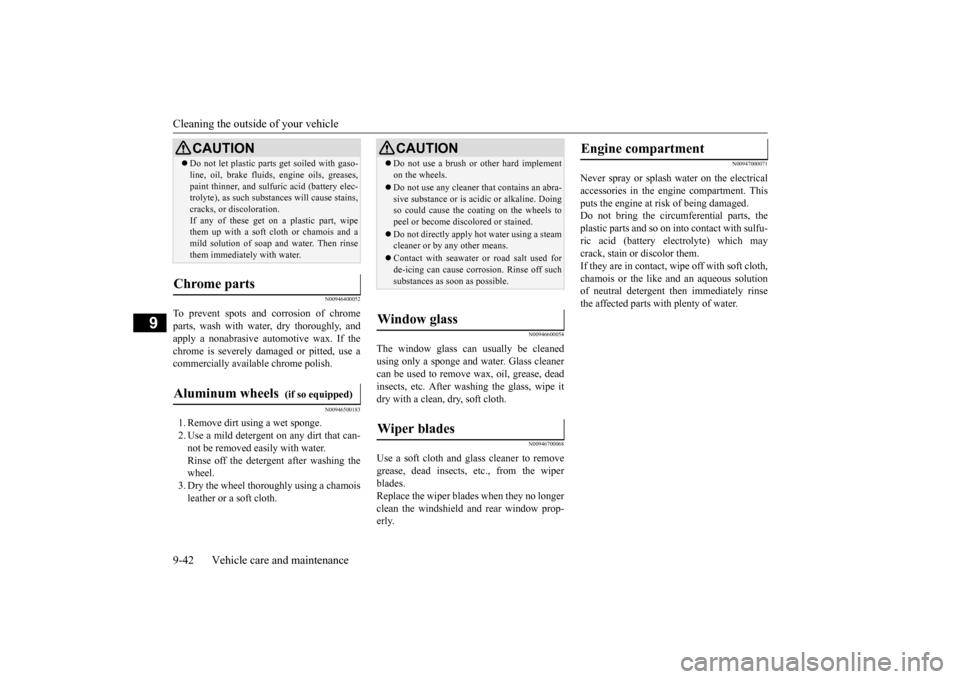
Cleaning the outside of your vehicle 9-42 Vehicle care and maintenance
9
N00946400052
To prevent spots and corrosion of chrome parts, wash with water, dry thoroughly, and apply a nonabrasive automotive wax. If thechrome is severely damaged or pitted, use a commercially available chrome polish.
N00946500183
1. Remove dirt using a wet sponge.2. Use a mild detergent on any dirt that can- not be removed easily with water.Rinse off the detergent after washing the wheel. 3. Dry the wheel thoroug
hly using a chamois
leather or a soft cloth.
N00946600054
The window glass can usually be cleanedusing only a sponge and water. Glass cleaner can be used to remove
wax, oil, grease, dead
insects, etc. After washing the glass, wipe itdry with a clean, dry, soft cloth.
N00946700068
Use a soft cloth and glass cleaner to removegrease, dead insects, etc., from the wiper blades. Replace the wiper blades when they no longerclean the windshield and rear window prop- erly.
N00947000071
Never spray or splash water on the electrical accessories in the engine compartment. Thisputs the engine at risk of being damaged. Do not bring the circumferential parts, the plastic parts and so on into contact with sulfu-ric acid (battery electrolyte) which may crack, stain or discolor them. If they are in contact, wipe off with soft cloth,chamois or the like and an aqueous solutionof neutral detergent then immediately rinse the affected parts with plenty of water.
Do not let plastic parts get soiled with gaso- line, oil, brake fluids
, engine oils, greases,
paint thinner, and sulfuric acid (battery elec- trolyte), as such substances will cause stains, cracks, or discoloration.If any of these get on a plastic part, wipe them up with a soft cloth or chamois and a mild solution of soap and water. Then rinsethem immediately with water.
Chrome parts Aluminum wheels
(if so equipped)
CAUTION
CAUTION Do not use a brush or other hard implement on the wheels. Do not use any cleaner that contains an abra- sive substance or is acidic or alkaline. Doingso could cause the coating on the wheels to peel or become discolored or stained. Do not directly apply hot water using a steam cleaner or by any other means. Contact with seawater or road salt used for de-icing can cause corrosion. Rinse off such substances as soon as possible.
Window glass Wiper blades
Engine compartment
BK0206700US.bo
ok 42 ページ 2014年3月25日 火曜日 午後4時42分
Page 366 of 384
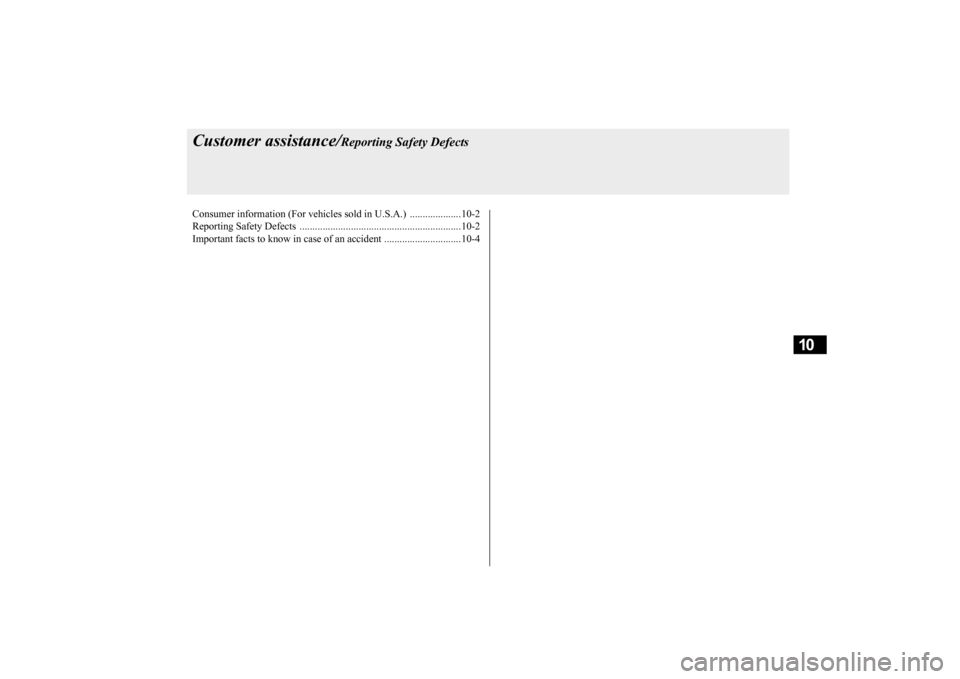
10
Customer assistance/
Reporting Safety Defects
Consumer information (For vehicles sold in U.S.A.) ....................10-2 Reporting Safety Defect
s ...............................................................10-2
Important facts to know in cas
e of an accident ..............................10-4
BK0206700US.bo
ok 1 ページ 2014年3月25日 火曜日 午後4時42分
Page 367 of 384
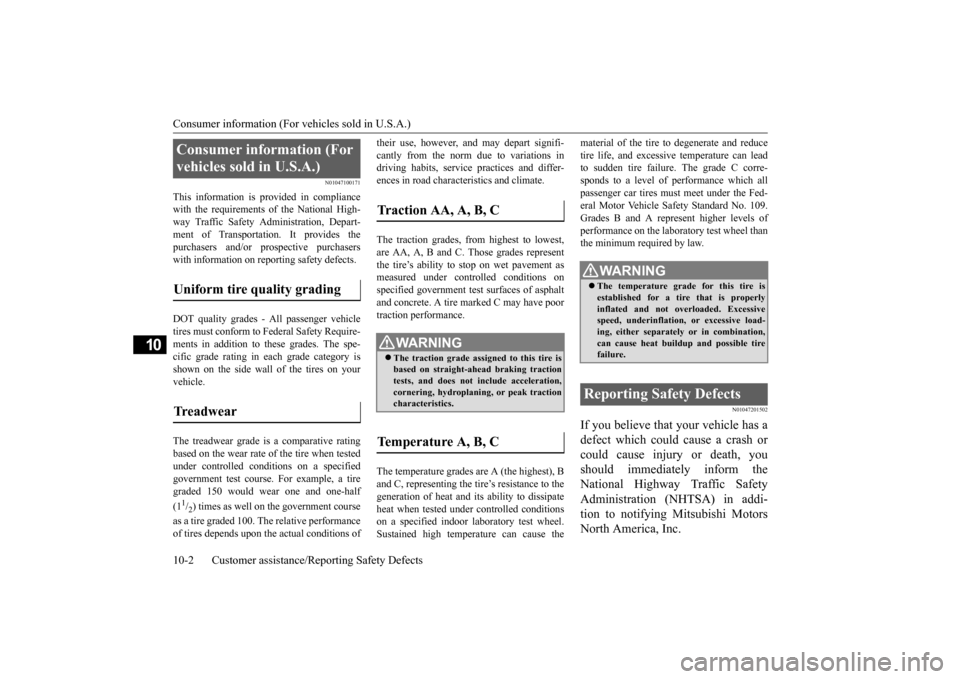
Consumer information (For vehicles sold in U.S.A.) 10-2 Customer assistance/Reporting Safety Defects
10
N01047100171
This information is provided in compliance with the requirements of the National High-way Traffic Safety Administration, Depart- ment of Transportation. It provides the purchasers and/or prospective purchaserswith information on reporting safety defects. DOT quality grades - All passenger vehicle tires must conform to Federal Safety Require-ments in addition to these grades. The spe- cific grade rating in each grade category is shown on the side wall of the tires on yourvehicle. The treadwear grade is a comparative rating based on the wear rate of the tire when tested under controlled conditions on a specified government test course. For example, a tiregraded 150 would wear one and one-half (11/2) times as well on the government course
as a tire graded 100. The relative performance of tires depends upon the actual conditions of
their use, however, and may depart signifi- cantly from the norm due to variations in driving habits, service practices and differ- ences in road characteristics and climate. The traction grades, from highest to lowest, are AA, A, B and C. Those grades representthe tire’s ability to stop on wet pavement asmeasured under controlled conditions on specified government test surfaces of asphalt and concrete. A tire marked C may have poortraction performance. The temperature grades are A (the highest), B and C, representing the tire’s resistance to thegeneration of heat and its ability to dissipate heat when tested under controlled conditions on a specified indoor laboratory test wheel.Sustained high temperature can cause the
material of the tire to degenerate and reduce tire life, and excessive temperature can lead to sudden tire failure. The grade C corre- sponds to a level of performance which allpassenger car tires must meet under the Fed- eral Motor Vehicle Safety Standard No. 109. Grades B and A represent higher levels ofperformance on the laboratory test wheel than the minimum required by law.
N01047201502
If you believe that your vehicle has a defect which could cause a crash or could cause injury or death, you should immediately inform the National Highway Traffic SafetyAdministration (NHTSA) in addi- tion to notifying Mitsubishi Motors North America, Inc.
Consumer information (For vehicles sold in U.S.A.) Uniform tire quality grading Treadwear
Traction AA, A, B, C
WA R N I N G The traction grade assigned to this tire is based on straight-ahead braking traction tests, and does not include acceleration, cornering, hydroplaning, or peak tractioncharacteristics.
Temperature A, B, C
WA R N I N G The temperature grade for this tire is established for a tire that is properly inflated and not overloaded. Excessive speed, underinflation, or excessive load-ing, either separately or in combination, can cause heat buildup and possible tire failure.
Reporting Safety Defects
BK0206700US.bo
ok 2 ページ 2014年3月25日 火曜日 午後4時42分
Page 368 of 384
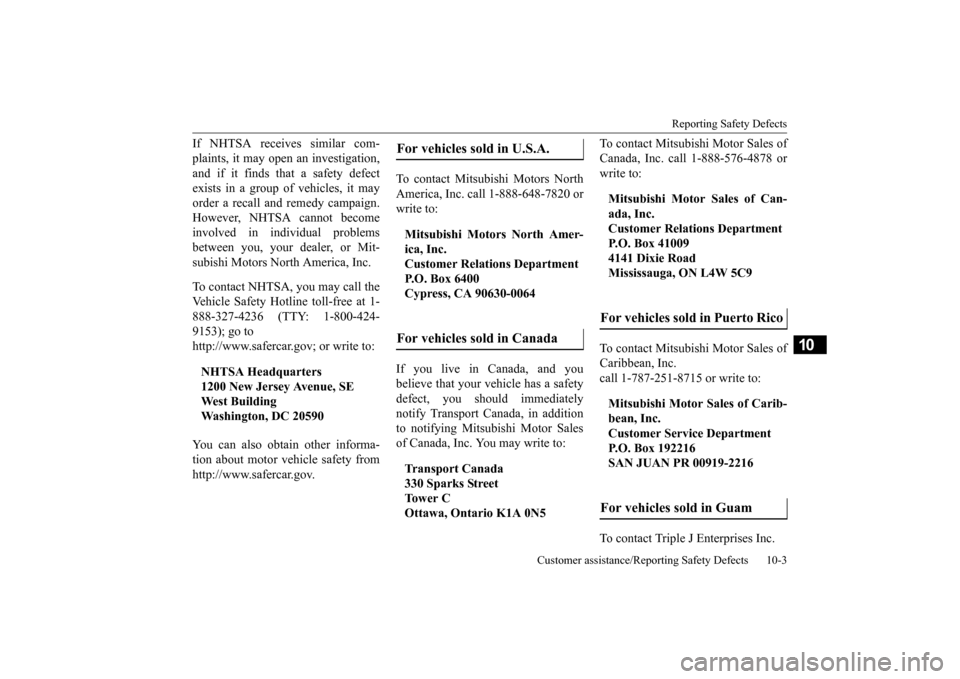
Reporting Safety Defects
Customer assistance/Reporting Safety Defects 10-3
10
If NHTSA receives similar com- plaints, it may open an investigation, and if it finds that a safety defect exists in a group of vehicles, it may order a recall and remedy campaign.However, NHTSA cannot become involved in individual problems between you, your dealer, or Mit-subishi Motors North America, Inc. To contact NHTSA, you may call the Vehicle Safety Hotline toll-free at 1- 888-327-4236 (TTY: 1-800-424- 9153); go tohttp://www.safercar.gov; or write to: You can also obtain other informa- tion about motor vehicle safety fromhttp://www.safercar.gov.
To contact Mitsubishi Motors North America, Inc. call 1-888-648-7820 or write to: If you live in Canada, and you believe that your vehicle has a safety defect, you should immediately notify Transport Canada, in additionto notifying Mitsubishi Motor Sales of Canada, Inc. You may write to:
To contact Mitsubishi Motor Sales of Canada, Inc. call 1-888-576-4878 or write to: To contact Mitsubishi Motor Sales of Caribbean, Inc. call 1-787-251-8715 or write to: To contact Triple J Enterprises Inc.
NHTSA Headquarters 1200 New Jersey Avenue, SE West BuildingWashington, DC 20590
For vehicles sold in U.S.A. Mitsubishi Motors North Amer-ica, Inc.Customer Relations Department P.O. Box 6400 Cypress, CA 90630-0064For vehicles sold in Canada Transport Canada330 Sparks Street To w e r C Ottawa, Ontario K1A 0N5
Mitsubishi Motor Sales of Can- ada, Inc. Customer Relations DepartmentP.O. Box 41009 4141 Dixie Road Mississauga, ON L4W 5C9For vehicles sold in Puerto Rico Mitsubishi Motor Sales of Carib-bean, Inc.Customer Service Department P.O. Box 192216 SAN JUAN PR 00919-2216For vehicles sold in Guam
BK0206700US.bo
ok 3 ページ 2014年3月25日 火曜日 午後4時42分
Page 369 of 384
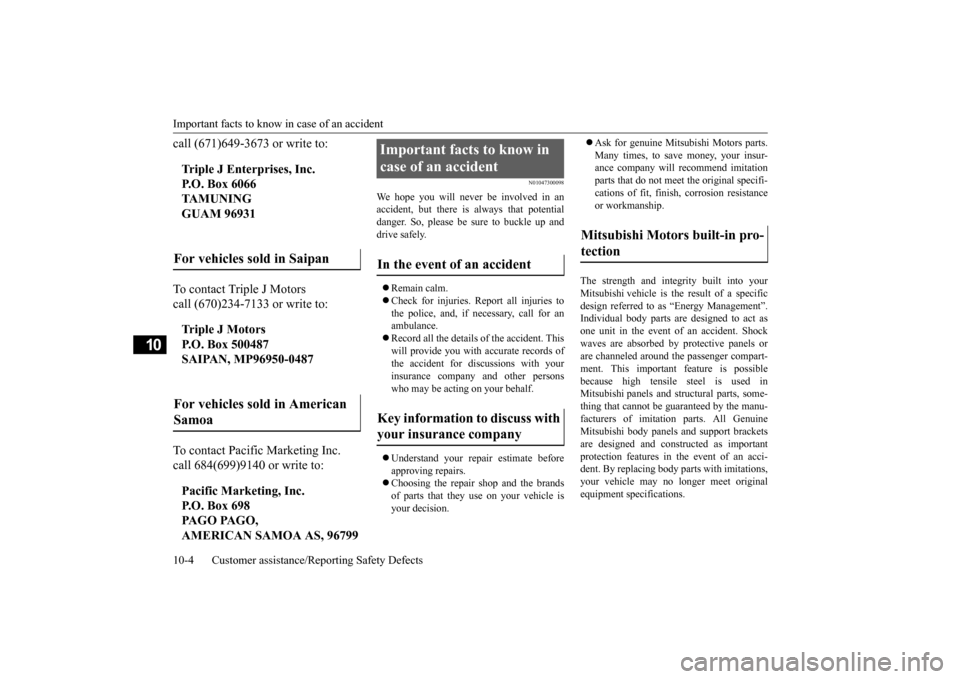
Important facts to know in case of an accident 10-4 Customer assistance/Reporting Safety Defects
10
call (671)649-3673 or write to: To contact Triple J Motors call (670)234-7133 or write to: To contact Pacific Marketing Inc. call 684(699)9140 or write to:
N01047300098
We hope you will never be involved in an accident, but there is always that potentialdanger. So, please be sure to buckle up and drive safely. Remain calm. Check for injuries. Report all injuries to the police, and, if necessary, call for an ambulance. Record all the details of the accident. This will provide you with accurate records of the accident for discussions with your insurance company and other personswho may be acting on your behalf. Understand your repair estimate before approving repairs. Choosing the repair
shop and the brands
of parts that they use on your vehicle isyour decision.
Ask for genuine Mitsubishi Motors parts. Many times, to save money, your insur- ance company will recommend imitation parts that do not meet the original specifi-cations of fit, finish, corrosion resistance or workmanship.
The strength and integrity built into your Mitsubishi vehicle is the result of a specific design referred to as “Energy Management”.Individual body parts are designed to act as one unit in the event of an accident. Shock waves are absorbed by protective panels orare channeled around the passenger compart- ment. This important feature is possible because high tensile steel is used inMitsubishi panels and structural parts, some- thing that cannot be guaranteed by the manu- facturers of imitation parts. All GenuineMitsubishi body panels and support brackets are designed and constructed as important protection features in the event of an acci-dent. By replacing body parts with imitations, your vehicle may no longer meet original equipment specifications.
Triple J Enterprises, Inc. P.O. Box 6066 TAMUNING GUAM 96931For vehicles sold in Saipan Triple J Motors P.O. Box 500487 SAIPAN, MP96950-0487For vehicles sold in American Samoa Pacific Marketing, Inc. P.O. Box 698 PAGO PAGO, AMERICAN SAMOA AS, 96799
Important facts to know in case of an accident In the event of an accident Key information to discuss with your insurance company
Mitsubishi Motors built-in pro- tection
BK0206700US.bo
ok 4 ページ 2014年3月25日 火曜日 午後4時42分
Page 370 of 384
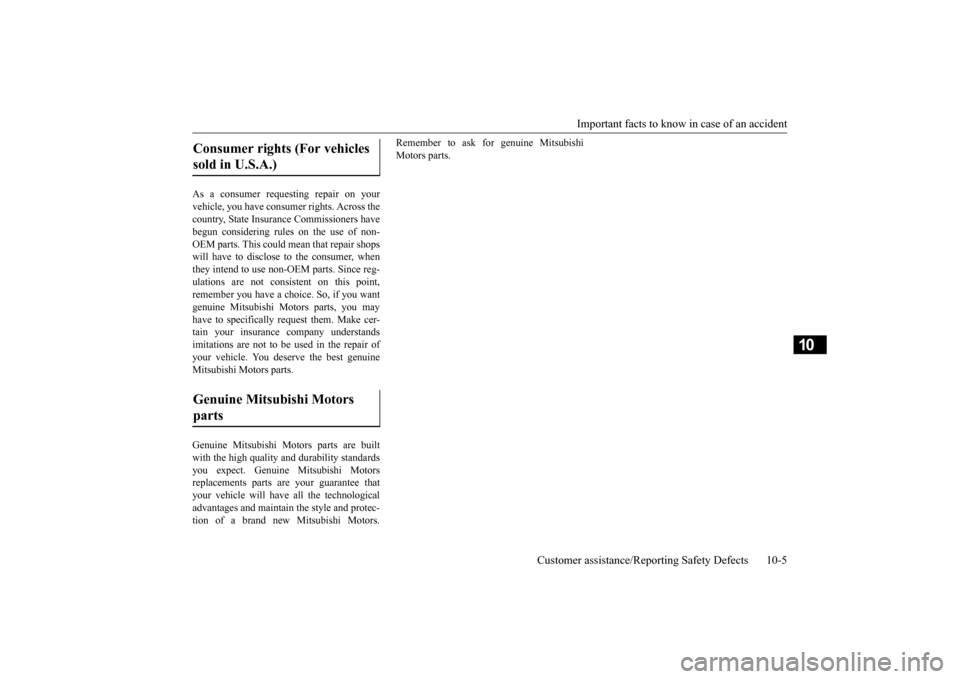
Important facts to know in case of an accident
Customer assistance/Reporting Safety Defects 10-5
10
As a consumer requesting repair on your vehicle, you have consumer rights. Across the country, State Insurance Commissioners have begun considering rules on the use of non-OEM parts. This could mean that repair shops will have to disclose to the consumer, when they intend to use non-OEM parts. Since reg-ulations are not consistent on this point,remember you have a choice. So, if you want genuine Mitsubishi Motors parts, you may have to specifically request them. Make cer-tain your insurance company understands imitations are not to be used in the repair of your vehicle. You deserve the best genuineMitsubishi Motors parts. Genuine Mitsubishi Motors parts are built with the high quality and durability standards you expect. Genuine Mitsubishi Motorsreplacements parts are your guarantee that your vehicle will have all the technological advantages and maintain the style and protec-tion of a brand new Mitsubishi Motors.
Remember to ask for genuine Mitsubishi Motors parts.
Consumer rights (For vehicles sold in U.S.A.) Genuine Mitsubishi Motors parts
BK0206700US.bo
ok 5 ページ 2014年3月25日 火曜日 午後4時42分